Comparative analysis of the thermal efficiency of a flat plate solar collector varying the glass type in the cover
Keywords:
flat plate solar collector, thermal efficiency, incident solar radiation.Abstract
A comparative analysis of the thermal efficiency of flat plate solar collectors for air heating due to incident solar radiation was carried out. Two flat plate solar collectors and conventional cover of dark and clear glass were used, which allowed determining the incidence of incident solar radiation on the air outlet temperature. Experiments were carried out under equal conditions with real-time data collection every minute for six hours a day and four conditions: without forced air, with forced air at 0,033 kg/s, 0,5 kg/s and 0,061 kg/s. The experimentation allowed defining that the application of dark glass decreases the thermal efficiency; the best values are obtained when using clear glass, the outlet temperature obtained reaches average values of 8,26 °C without forced air. The comparative thermal performance between solar collectors with clear and dark glass covers shows values that reach 12 % in clear glass covers, the experimental incident solar radiation values varied between 200 W/m2 and 1 500 W/m2.Downloads
References
Avadhesh, Y. and Bajpai V. 2011: An experimental study on evacuated tube solar collector for heating of air in India. International Journal of Mechanics and Mechatronics Engineering, 5(7): 1188-1193.
Ávila, A.; Mendoza, J. y Beltrán, J. 2010: Evaluación energética de un colector solar de placa plana de doble cubierta. Ingeniería y Desarrollo, 27(1): 93-112.
Babu, S. and Chinnapandian, M. 2017: The performance study of a solar flat plate type air collector with natural and forced convection. Industrial Pollution Control, 33(2): 1155-1162.
Bahrehmand, D. and Ameri, M. 2015: Energy and exergy analysis of different solar air collector systems with natural convection. Renewable Energy, 74(1): 357-368.
Bahrehmand, D.; Ameri, M. and Glolampour, M. 2015: Energy and exergy analysis of different solar air collector systems with forced convection. Renewable Energy, 83(1): 1119-1130.
Bisen, A.; Dass, P. y Jain, R. 2011: Parametric studies of top loss coefficient of double glazed flat plate solar collector. International Journal of Mechanical Engineering, 1(2): 71-78.
Fudholi, A.; Sopian, K.; Mohd, H. and Yusof, O. 2011: Thermal Efficiency of Double Pass Solar Collector with Longitudinal Fins Absorbers. American Journal of Applied Sciences, 8(3): 254-260.
Gopi, R. and Kalam, A. 2017: Experimental investigation of flat plate collector with cylindrical fins in a solar air heater. Industrial Pollution Control, 33(2): 1128-1131.
Kayiem, A. and Tadahmun, Y. 2015: On the natural convection heat transfer in a rectangular passage solar air heater. Solar Energy, 112(1): 310-318.
Koulibaly, A. y González, J. 2015: Modelación de un colector solar para calentamiento de aire. Ingeniería Energética, XXXVI(3): 282-293.
Ravi, K. y Saini, R. 2016: A review on different techniques used for performance enhancement of double pass solar air heaters. Renewable and Sustainable Energy, 56(1): 941-952.
Saxena, A. and Sebaii, E. 2015: A thermodynamic review of solar air heaters. Renewable and Sustainable Energy Reviews, 43(1): 863-890.
Sharma, S. and Som, N. 2017: Exergy Based Performance Analysis of Double Flow Solar Air Heater with Corrugated Absorber. International Journal of Energy and Power Engineering, 11(12): 1212-1218.
Tamayo, E.; Guadalupe, J.; Mediaceja, Y. and Díaz, E. 2017: Mathematical modeling of the natural solar drying process in lateritic mineral deposits. International Journal of Mechanics, 11(1): 182-187.
Torres, E.; Morales, J.; Albarracín, M. and Laurencio, H. 2021: Cooling temperature and heat transfer coefficients in cylindrical heat exchangers. International Journal of Mechanics, 15(1): 254-259
Published
How to Cite
Issue
Section
- Authors retain copyright and guaranteeing the right magazine to be the first publication of the work as licensed under a Creative Commons Attribution-NonCommercial that allows others to share the work with an acknowledgment of the work's authorship and initial publication in this journal.
- Authors may establish separate supplemental agreements for the exclusive distribution version of the work published in the journal (eg, place it in an institutional repository or publish it in a book), with an acknowledgment of its initial publication in this journal.
- Authors are allowed and recommended to disseminate their work through the Internet (e.g., in institutional telematic archives or on their websites) before and during the submission process, which can produce interesting exchanges and increase citations of the published work. (See The effect of open access)



